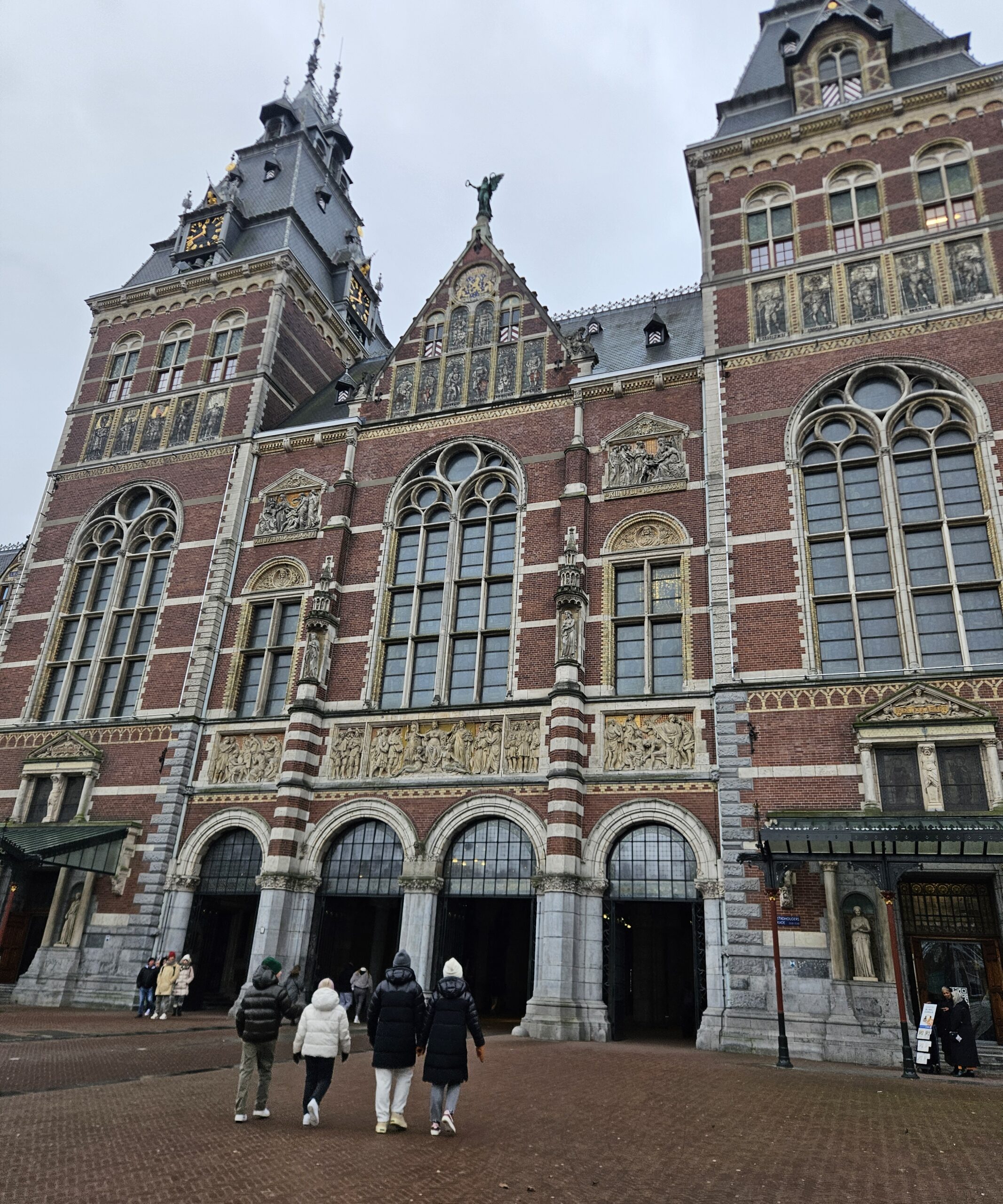We like to explore our destination’s history and unique artefacts. So on our Northern European Tour in 2024, we went to some of Amsterdam’s major galleries and museums.
Rijksmuseum
The Rijksmuseum, Amsterdam’s oldest and grandest gallery, dominates the Museum Quarter in the city’s south west. To get in, snag your €25 ticket online—then breeze through security and dive right into the heart of the action. With four floors to explore, including two main wings and a side branch, there’s no shortage of masterpieces to discover. Built in 1885, the museum’s architecture is a work of art in itself—soak it all in as you wander. We skipped the cloakroom queue and decided to brave the galleries with our coats in tow instead.




We kicked things off on the ground floor, but not before grabbing a quick drink at the café. Don’t be fooled by the name—this place is staffed by dapper waiters and serves up full meals alongside coffee and alcoholic drinks.
Our first stop? The special exhibitions, where we marvelled at Dutch plates and porcelain, vintage musical instruments, and stunning depictions of the Dutch shipping fleet. On the other side of the building, we were drawn into a captivating collection of religious art and sculpture.




Next we headed to the Asian Pavilion to check out statues and artefacts from the days when the Dutch Empire spanned into Asia. From ornate kimonos to ancient weapons and towering statues, it was a fascinating glimpse into a distant world. Since this exhibit was in the basement, there were a few steps to navigate in and out.
Next, we took the grand central staircase to the first floor, where the 1700-1900 collection awaited. We explored a rich array of Delftware, silver, sculptures, and some quirky pieces of antique furniture. As we wandered, we noticed the crowds gathering around a room showcasing three iconic Vincent Van Gogh paintings. Sadly, the paintings were missing, but the related artwork kept us entertained.




On the first floor, we stumbled upon the library, a peaceful retreat marked with “Silence Please” signs. Most people followed the rule, except for a few lively Asian tourists. The library spanned three floors and was impressively large, though a bit more utilitarian than we had imagined. No grandiose architecture, just shelves of books and a straightforward layout. It wasn’t quite the majestic space we’d expected, but still a quiet spot to soak in the scholarly atmosphere.




We made our way to the second floor. Here the gallery expanded thanks to the impressive North/South transom room, home to the iconic “Gallery of Honour.” At one end, Rembrandt’s massive The Night Watch commanded its own climate-controlled room. The rest of the gallery was filled with alcoves dedicated to Vermeer, Steen, and Hals. Each one was designed like a mini cathedral to art, with the artists’ names painted proudly above their displays.
As we ventured further into the second floor, we found rooms dedicated to individual artists from the 1600s to 1700s. These showcased a mix of paintings and sculptures. The pieces were stunning, but it was clear why Rembrandt and Vermeer are considered true masters. Their work truly stood apart. Among the physical artefacts, we were blown away by a few rooms featuring incredibly detailed dolls’ houses. Each one is a miniature marvel of craftsmanship.
Finally, we headed up to the third floor, which was devoted to art from 1900 to 2000. Unfortunately, we missed the entrance and didn’t get to explore the two separate rooms on that level.
Diamond Museum
By the time we stepped out of the Rijksmuseum, the rain had started to pour. We quickly sought refuge in the nearest shelter. Luckily, that turned out to be the Diamond Museum, just a short walk away. Tickets were €12.50, and the museum spans three floors—perfect for an hour-long escape from the weather.
We kicked things off with a fascinating video explaining where diamonds come from, how they’re mined, and where they can be found. Afterward, we dove into an exhibit showcasing the intricate process of cutting, polishing, and grading diamonds. Displays are in both English and Dutch. It was a sparkling journey into the world of one of nature’s most dazzling treasures.




There was a fascinating display of replica famous diamonds. Some were set in their original settings, others just raw gems. Each one had its own intriguing backstory, but the most interesting tidbit was about one missing diamond. The Golden Jubilee is the largest diamond in the world. It currently resides in the private collection of the King of Thailand, so it can’t be measured for a replica.
Up on the next floor, we discovered replicas of crown jewels from around the globe, as well as some stunning examples of diamonds used in modern art and jewelery. Among the highlights was an ape’s skull adorned with 17,000 diamonds, and a replica of Banksy’s red diamond-covered human skull. Talk about sparkle with a twist!
Moco Museum
The Moco Museum has a different vibe. It is housed in an old merchant house that’s been transformed into a quirky gallery. Since it wasn’t purpose-built, some rooms are a bit cramped, especially with the crowds buzzing through. The museum showcases works by Banksy, Warhol, and even a display by Robbie Williams, along with a wide array of modern art and sculptures. Tickets range from €18 to €22, depending on the time of day you book online.
We did run into a bit of frustration, though. Despite buying our tickets in advance, we still had to wait outside in the rain until our allotted entry time. Meanwhile, it seemed like those who hadn’t bought tickets online were able to waltz right in—quite the puzzling experience!




The Modern and Contemporary art at Moco can definitely be a bit of a head-scratcher for some. Banksy’s graffiti art was undeniably entertaining, while Keith Haring’s childlike doodles might leave people thinking, “I could do that!” We also found ourselves a bit puzzled by Yayoi Kusama’s dotted pumpkins—definitely strange, but oddly captivating. It’s the kind of art that might challenge your perception, but that’s what makes it so intriguing!








Damien Hirst’s Mickey Mouse, created from 12 colourful diamond dots, was a clever piece that hangs above the stairwell. After taking in the main exhibits, we descended into the basement. Here we discovered a series of art installations. There was a reflective room filled with diamond shapes, a space dominated by massive screens, a padded room, and several other mind-bending environments. Naturally, all of this led us straight to the gift shop—where temptation awaited—before we made our way to the exit.
Café Welling
After a bit of exploring, we were craving a drink and a chance to relax, so we searched for the nearest bar. Café Welling, established in 1928, turned out to be a cozy, no-frills local pub with plenty of charm and character. I think we were the only non-Dutch people in the place, but that didn’t stop us from snagging seats right at the bar. The owners were helpful and down to earth. They were happy to recommend a local beer and the prices were excellent. There was no music, but a piano sat quietly in the corner. The small bar was packed with tables, all buzzing with content locals enjoying their evening.




We had an amazing time at Café Welling, with the bar staff taking excellent care of us. They guided us through the local drinks and explained some of the unique selections on the menu. But what really stole the show was the extravagant Christmas decorations, which completely overtook the ceiling. The entire space was transformed into a magical winter wonderland. It added such a whimsical touch to the experience.







